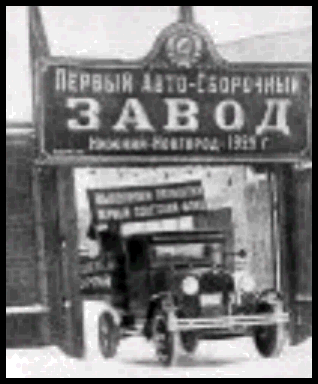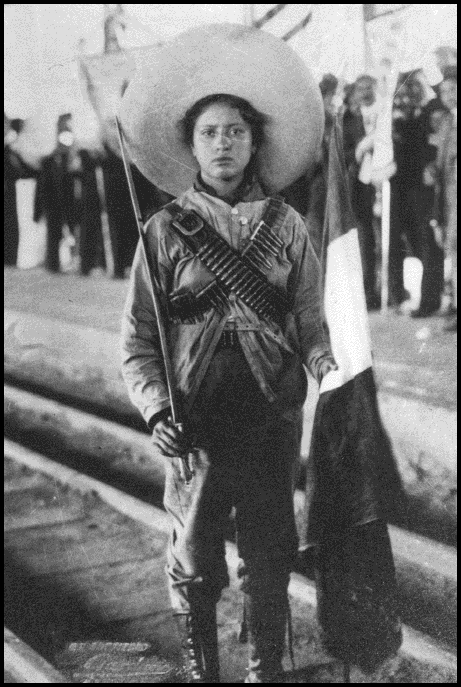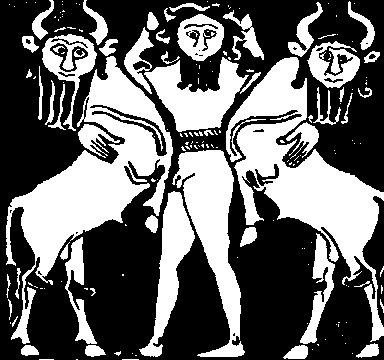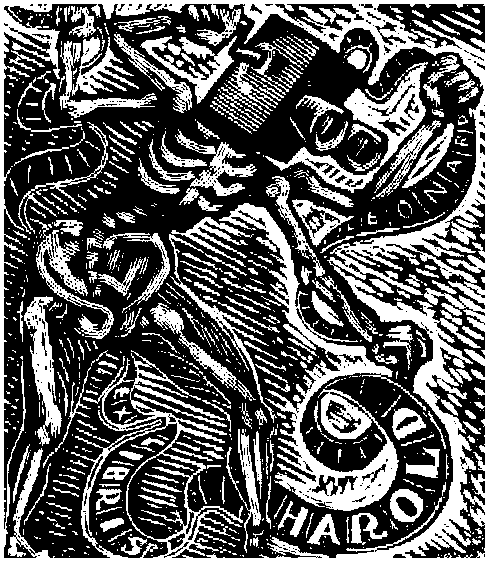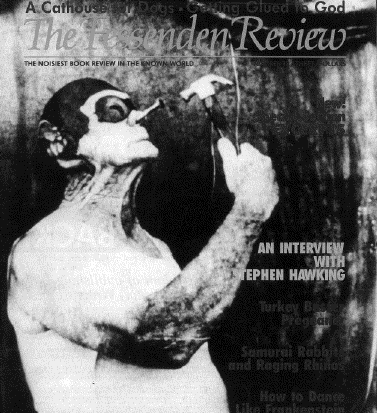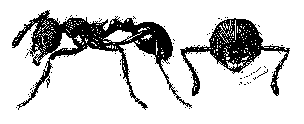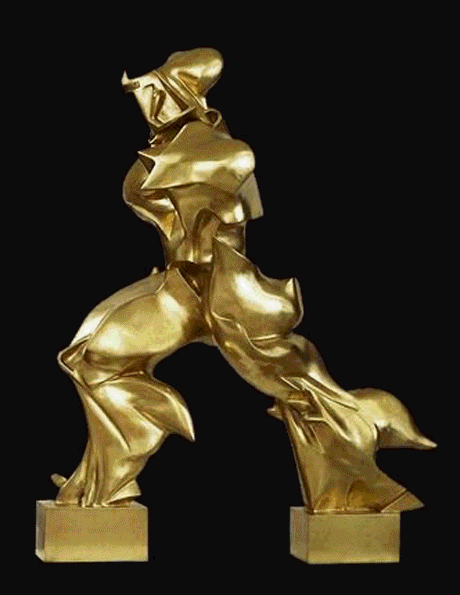Every month, our server provides us
with an updated list
of the poems, readings, articles or
book reviews that continue
to receive the most hits
and (presumably) the
affection of our readers.
Here are the
Top Twelve.
Josef Müller-Brockmann
(Phaidon)
- Illustrative
- Objective-Informative
- Constructive
- Experimental
- Series
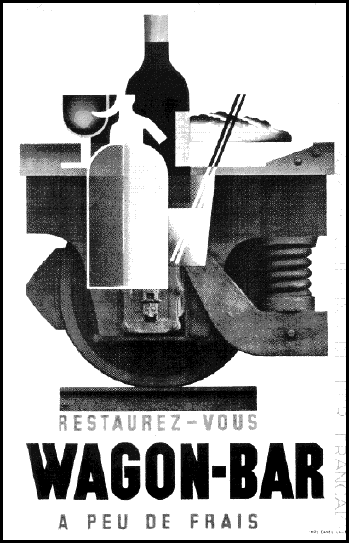
The artist Pierre Bonnard shows his scrawly side on La Revue Blanche and L'Affiche Revue D'Art, and Théophile Alexandre Steinlen sports a monster rooster (with the unusual rosecomb crest) in a poster of an exhibition that included Francoise Villon and fifteen other artists of the times.
Müller-Brockmann claims that the earliest posters were made of stone, bore Hammurabi's Code and were published --- if that is the right word --- 4,000 years ago. By this logic, every tombstone ever pounded out is also a poster, an idea we find not without merit. "What are you doing all day in the Happy Valley Cemetery?" "Why I am reading the posters."
The first printed posters came out of 1556 Wittenberg, says the author, but one could point out that gold-and-red hand-lettered illuminated manuscripts were posters for the divine as produced by medieval monks. There is a small reproduction here of Toshusai Sharaku's famous woodcut representation of a Japanese actor from 1784. It is said that this was the style that attracted the French Impressionists, reflected in the works of Chéret, Toulouse-Lautrec, et al.
The section "Objective-Informative" contains ads for Opel cars (1911!), Kaiser coal brickettes, Stiller shoes (a wonderful rendition), Manoli cigars, and a very ugly poster for Vasily Kandinsky's 60th Birthday exhibition when he was part of the Weimar Bauhaus school.
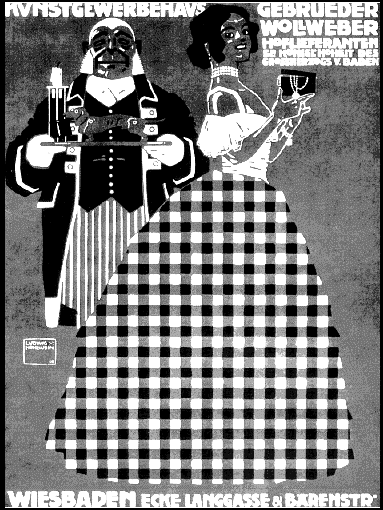 The posters in the "Objective-Informative" section after the 30s are pretty dull, especially a 1951 tic-tac-toe job on the New York Times by Kenneth D. Haak. Of Constructive posters, whatever that means, we have the lovely 1932 "Wagon-Bar" tourist poster by A. M. Cassandre [Fig. 2 above] which, if you think about it is positively deconstructive, uniting wheel and seltzer water into a pleasant mix. Most of the Constructives are stark, tacky, and less interesting.
The posters in the "Objective-Informative" section after the 30s are pretty dull, especially a 1951 tic-tac-toe job on the New York Times by Kenneth D. Haak. Of Constructive posters, whatever that means, we have the lovely 1932 "Wagon-Bar" tourist poster by A. M. Cassandre [Fig. 2 above] which, if you think about it is positively deconstructive, uniting wheel and seltzer water into a pleasant mix. Most of the Constructives are stark, tacky, and less interesting.
The final Experimental posters are not so different from all the others, only a little less pleasing to the eye, a little more brutish. Our favorite of them all is Ludwig Hohlwein's lithograph of a Wiesbaden arts and crafts shop [Fig 3], where the skirt threatens to envelope everything, even the poster, much less the inhabitants, in its lovely crosshatching.
Mother exPosed
Gay Block
(University of New Mexico Press)

- My first series consisted of portraits of people who were friends of my parents, mostly affluent, reform Jews who lived in Houston. The camera enabled me to enter these peoples homes and hear the stories of their lives ... The camera made me different from Mother even as it gave me access to her. It occurred to me much later that no matter who was in front of my camera, I was always photographing Mother."
Gay. I didn't learn love from you...I don't remember you touching me...
Bertha Alyce: Now I really think you've had too much psychoanalysis, Gay.
Gay: And you had too little, like none.
review
Antonia Fraser
Wanda McCaddon, Reader
(Audio Editions)
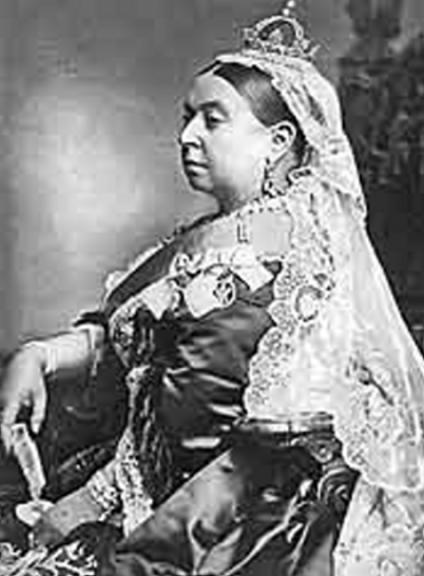
review
A Memoir by the
Daughter of Erik H. Erikson
Sue Erikson Bloland
(Viking)
- Families in which each member is separated from the others by asbestos walls of verbal propriety, overt sweetness, cheap frankness, and rectitude tell one another off and talk back to each other with minute and unconscious displays of affect --- not to mention physical complaints and bodily ailments --- with which they worry, accuse, undermine, and murder one another. . . . .
but Bloland doesn't seem to read (much less to get) his impressive message.
In fact, she wasn't, apparently, at all impressed by her father, who was so ahead of his times in studies of family systems. She dwells inordinately on the distance, the outbursts of temper, his apparent favoritism towards her older brothers. The god of the newest 1950s theories of family dynamics was, she is telling us, a lousy family man.
Big deal. As my friend Tom Connors used to say, another person with a monkey on her back. Her gloomy style, and her passion for repeating herself does nothing to set the reader on fire. How many times do we have to hear of Erikson's fixation on the fact that his missing father might have been of the Danish nobility?
It all turns into a bummer, especially for those of us who don't give a toot about the eccentricies of artists. Do you and I care that Norman Mailer beat up on his lovers, Gauguin died of syphilis, Hart Crane liked taking on sailors (and getting beat up by them), that Edna St. Vincent Millay was named after a hospital? Sorry, Bloland. The only perfect saint died 2500 years ago, and civilization ain't in any hurry to reproduce another.
review
A Cultural History of Outdoor Sculpture
In the Nation's Capital
Hames M. Goode
(Johns Hopkins)
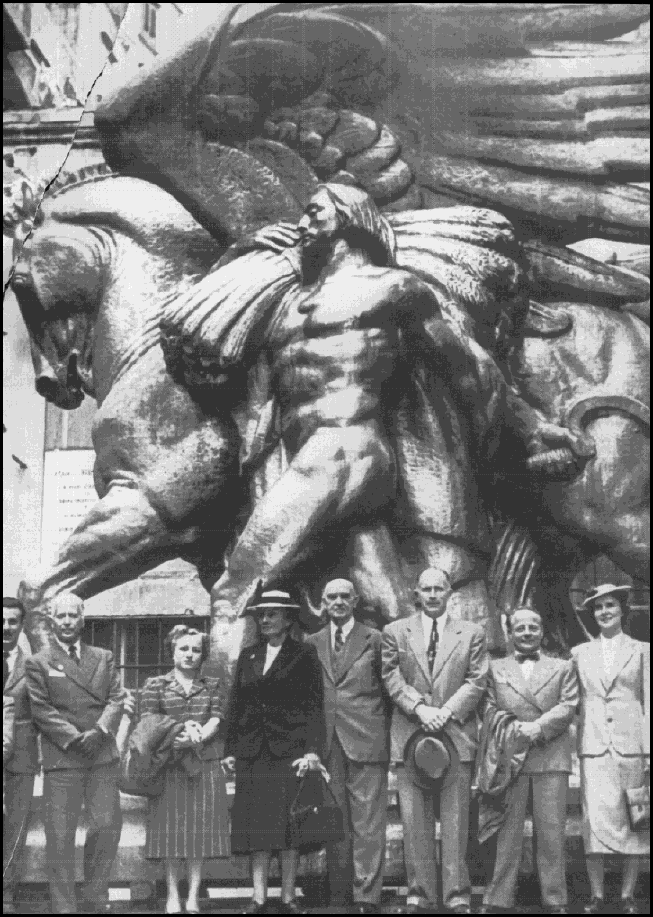
Editor Goode tells us there are over 500 outdoor sculptures in Washington, D. C. although at times it may seem like there are many more. He is generous, though, for he not only includes the equestrian statues and those national heroes with swords and busts, he brings in cemeteries, inner courtyards, hidden nooks ... and parts of Virginia and Maryland, too.They are gathered in this definitive volume, all are given at least one picture (sometimes several angled shots) and the whole weighs in at a ton or so (the book, not the busts). Washington Sculpture runs almost 800 pages.
It's a heroic effort and it is hard to stop leafing through it to see what other silly figures are to be commemorated in the traffic circles, parks, courtyards, sidewalks, cemeteries ... and sometimes right out on the city streets. One is tempted to try to make sense of all these colonnades and fountains and memorials and the only way I could figure out to do it was to list them by official scientific category.
Go to the complete
reviewThe Forsaken
An American Tragedy in Stalin's Russia
Tim Tzouliadis
(Penguin)The book under review tells the story of a little-known and somewhat unusual group of victims of the Great Terror in the USSR. In the early 1930s, a few thousand Americans went to the Soviet Union to work, many of them in the belief that the move was temporary. Some of these individuals were idealistic Communists, who wished to contribute to the building of socialism. Others, less overtly political although perhaps vaguely sympathetic to the USSR, were leaving the USA in the depths of the Great Depression primarily to find work. Finally, another group of several hundred were employees of the Ford Motor Company. In 1929, the arch-capitalist Henry Ford, after reassuring himself that Stalin had no trace of Jewish blood, had signed a 40 million dollar deal to erect a complete Model A manufacturing facility in the USSR. The agreement called for a contingent of Ford workers to get production going and to train the Russian workforce. So, between August of 1930 and November of 1931, a giant Ford car plant was built outside of Nizhni Novgorod, an old city on the Volga some 200 miles east of Moscow. Stalin, who admired American industry, hoped that it would become the Soviet Detroit. The American workers called it "Nizhny New York," and the Soviet authorities renamed it Gorky.For the first few years, the Americans were welcomed, and some learned Russian and put down roots of a sort. Others worked for a time and then decided to return home. At first, this was not difficult. Walter Reuther (later president of the UAW) and his brother Victor worked briefly at Nizhny Ford, and returned to the US in 1935. By then, however, many of the Americans began to encounter bureaucratic difficulties, like those described in this note hand-delivered to the new US embassy in Moscow in 1935: "After 8 months of work I decided to go back to the United States. ....they told me they are not going to give me papers, because they need me as a specialist in the factory. ...They scared me with threats to put me in jail. ...They told me they would rather kill a person like me than let him out of the country." Some American workers found that the Soviet authorities, who had taken their American passports "temporarily" for safekeeping when they entered the USSR, would not return the passports. The Americans found themselves trapped. And trapped in a maelstrom typified, at the top level, by the Moscow Trials of 1936, 1937, and 1938.
Go to the complete
reviewThe Party of Moderate Progress
Within the Bounds
Of the LawFriends, we are where we did not want to be, as the man said when he wanted to go to Budejovice and got into a train going in the opposite direction. He was caught by the Inspector for occupying a second-class seat when he only had a third-class ticket, and was thrown off the train at Bakov. Because one of the first precursors of our Party, Mr. Galileo Galilei, said as I do: "But, all the same, it goes round," Miss Bozenka, please serve one more round: three more beers for me, two beers and one cognac for Mach, two beers and one allasch for Opocensky, a quarter of a litre of white wine for Langer, a beer and a magador for Divis, and a soda water for Gottwald. So Galileo's words "it goes round" are proved true, and it is also abundantly clear that the Party of Moderate Progress knows how to defend itself and looks after the interests of the voters.After this digression, ladies and gentlemen, let us return to our theme and devote a few agreeable moments to abusing the opposing candidates. Just today, at the beginning of the meeting here, the poet Louis Krikava, who not only has the same name as the police director and government counsellor Kirkava, but is in confidential touch with him, gave the executive committee of our Party a piece of information which we gave our word of honour to keep strictly secret.
According to this, which is strictly confidential and known to only about three people in Prague, at two p.m. yesterday the Young Czech candidate, Dr. Funk, knocked at the gates of the Convent of the Barnabites next door to the Schwarzenberg Palace, allegedly only in order to persuade the Mother Superior of that order to influence the votes of the clergy. He did this in spite of the fact that, as a freethinking Young Czech candidate, he must have been aware of the church regulation forbidding Barnabites to have any contact with a man, especially at two P.M. in the afternoon...
Today, my dear friends, if I am to recapitulate the statistical data you have already heard me quote, then we must tell ourselves that figures cannot lie. ... And those principles, my dear friends and voters --- whether we look at them from the point of view of the nation, the minorities, social justice, trade, or religion --- these principles, I say, cry out to you in the name of moderate progress within the bounds of the law, so that it must be clear, even to every idiot, that there is only one thing to be said, and that is: "Elect me!"
Go to the complete
articleLas Soldaderas
Women of the Mexican Revolution
Elena Poniatowska
David Dorado Romo,
Translator
(Cinco Punto Press)If you were a woman, and wanted to help the Revolution, it was best to be with Zapata. The soldiers were always "caballeros." Josefina Bórquez relates how she and four Carrancista friends were detained in Guerrero. When the general arrived in Chilpancingo, Zapata personally delivered them to him. He told his men,Stay behind. Nobody goes with me. I want to show the Carrancistas that I fight for the Revolution, not to take possession of their women.
When a sentry asked, "Who goes there?" he responded,
"Zapata."
"You're Emiliano Zapata."
"I am."
"Well, I find it strange that you come without protection."He said of the women, "No one has touched them; I bring them back to you exactly as we found them."The Centaur of the North was not so gentlemanly, and his opponents were not caballeras, either. In Chihuahua, sixty soldaderas were captured. One of them tried to shoot Villa. "Ladies, who fired that shot?" he asked. No one responded. He tied them up "like stacks of firewood or barrels," ready to set them on fire. "The soldaderas screamed, not out of pain, but out of rage. There were no moans coming out of the women's mouths, only insults. They didn't plead for mercy, instead they threatened an impossible revenge."The most blunt, vile and violent insults were heard coming from those piles of women pressed tightly against each other by the ropes. Sixty mouths cursing at once...
After they were afire, "the women never stopped cursing Villa."
And after the blaze completely covered them, Villa heard a hoarse voice screaming from the pyre: "You dog, son of a bitch! You will die like a dog!"
Go to the complete
reviewFamily Reunion:
Poems about Parenting Grown Children
Sondra Zeidenstein, Editor
(Chicory Blue)If you are planning to have any children in the next twenty-five years ... don't. Unless you are looking forward to fifty years (or more) in which you get to deal with alcoholism, anorexia, sullenness, blame (you!), sickness, lack of appreciation, inability to communicate, self-destructive behavior, late-night telephone calls, crying jags, grandchildren with life-threatening illnesses, and endless money-begs.She wants to hang herself from the rafters, she says
to me at the top of the stairs...Those are the opening lines of Joan Swift's poem "Ties," while Cortney Davis tells us about being in the airport café:How's work? I'll ask my son, trying to catch up.
He'll concentrate on his plate. I'll pick up the bill.Raymond Carver reports, "Oh, son, in those days I wanted you dead / a hundred --- no a thousand --- different times." And how about his daughter?You're a beautiful drunk, daughter.
But you're a drunk. I can't say you're breaking
my heart. I don't have a heart when it comes
to this booze thing.Pearl Garrett Crayton tells us to be very careful, "Please, please, please, please, please / don't step on my daughter's toes!" Why? She'll
cut you down to size,
scratch your eyes out,
pull out your hair,
go for your jugular vein,
flay you skinless,
trample you in the dust.By comparison: "I've seen cancers cause less misery."
Penelope Scambly Schott tells of the telephone call, and "the spooked nickering of my grown daughter / across three thousand miles of dark, / that iron shoe in my heart," while Sheila Gardiner explains that her daughter's "What will I do with the rest of my life?" ("dissolving my heart") comes "from years of paralysis."
And just so we'll know that this stuff reaches across ages, Judith Arcana interviews Jocasta in hell, asks how come she gave up her son. She says Laius bullied her into doing it, but mostly she was "crying over my loose belly, still soaked in milk." Besides, "He was king." Besides, who was to know, who in god's name could ever know,
When you look down at them in their baskets, wrapped in soft cloth, when they root for the nipple under your gown, pursing their tiny budlipped mouths toward the smell of you, their eyes still fogged, still changing.
"How could I have recognized him?" she wails, as every mother must wail when she looks into the eyes of her newborn and has no idea, no idea in god's great world that the babe in arms may someday rise up to smite the old man, strike him dead, then bury himself in the arms of the widow, the one who could not, not in a thousand thousand years, guess that this lovely young man, "my mysterious suitor, the supposed savior of my city" is, in truth the soon to be her blind --- blinded by his own hand --- son, that one-time "nuzzling, budlipped babe" of her own womb, now returned to her womb. In another direction, in another guise.
Go to the complete
review
Leopoldo Méndez
Revolutionary Art and the Mexican Print
Deborah Caplow
(University of Texas Press)The artists of Mexico who lived through the ten-year Revolution were lucky. Not only did they survive upheaval, starvation, and the ruination of the country, but then they had the chance to experience the glorious artistic explosion that followed.We are speaking here of the years from 1920 to 1940, the time of Diego Rivera, David Siqueiros, José Orozco, Frida Kahlo, and the talented practitioners of Mexican engraving: Jean Charlot, Ramón Alva de la Canal, Pablo O'Higgins, and, probably the greatest of them all, Leopoldo Méndez.As opposed to the politically and socially castrated American artists of the 20s, Rivera, Siqueiros, Méndez et al were deeply involved in the politics of their country, if not the world. Many were also involved in government projects to bring Art to the People. In the United States, and belatedly, this was administered by the WPA. In Mexico, it was brought about through the ægis of the Ministry of Education. Méndez himself spent a year or so as a teacher in villages of Central Mexico.His main shtick, there in the sticks, was to get rid of Oscar Wilde's notion of "Art for Art's Sake." Art was, as he and Rivera and Siqueiros saw it, to free the workers, to lighten the burden of the campesinos, to uplift the poor, to unburden the rich of their excessive wealth.
Méndez, Ms. Caplow convinces us, was a dedicated printmaker and painter, a self-sacrificing revolutionary, a loyal comrade, and a good friend. He comes across as self-effacing, dedicated, more interested in communicating the evils of greed and violence rather than, like Rivera, pumping up his own balloon. His most moving prints are not the sometimes crude caricatures of captains of warfare and industry, but views of the humble peasant, the worker in the field, the poor drudges in the factories, the scattered heirs of Emiliano Zapata.Go to the complete
review
The Last
Sideshow
Hanspeter Schneider
(Dazed)In 1985, our forebear The Fessenden Review put a picture on the cover of an old guy pounding a nail up his nose with a hammer. He's here. His name is Melvin Burkhardt. Only in this book, he's featured with a lady friend doing the pounding. It's a huge nail. He calls himself "The Human Blockhead" and his doctor once told him, "Quit or your brain will get scrambled." He never did.Norbert Terhune (Dwarf and Fire Eater) appears on the cover of The Last Sideshow. He's in retirement so he has a hearing-aid (regular size). We get a shot of him setting his mouth on fire.The sideshow promoter and production manager is named Chris Christ. The Half Lady gets around in a wheelchair because, well, she's only half there.
She tells us, "My mother said 'You're the prettiest little baby I ever saw.' This made me feel really good. It still makes me feel really good." Ward Hall, promoter, says, "Until you've sat up all night with the Fatman in a hospital emergency room, you can't be a sideshow expert."
Judy Tomaini is shown holding a pistol up to her cheek. She reports, "When your father is an 8' 4" giant and your mother is 2ft. 6 inches with no legs, some outsiders must think you have a really weird home life."
Go to the complete
review
Owls
Cynthia Berger
(Stackpole)Owls should be the most lovable of them all, but after reading Cynthia Berger's catalogue of their eating and living habits, I think you'd be better off with a lemur or a platypus.Take your typical strigiformes diet. Gopher stew. Voles on toast. Lemming squash. Nuthatch fricassee. Duckling soup. Moth paste. Cat flambé. And, yuck, the common dung beetle.
According to Ms. Berger, the Burrowing Owl goes about the prairie picking up "cowpies, horse manure, dog dirt, whatever" and "arranges the smelly treasures around the entrances to their burrows." They also line the inner walls of their little cellars with this crap.
Some nosy scientists thought they were dragging this foul mess home to fool their predators, who would leave off digging in and stealing their eggs because it all was so revolting. Not so. The Burrowing Owl has a vast appetite for dung beetles. Dung beetles go to, well, where the shit is. It's a drive-in restaurant for the owls, except instead of going through the golden arches to get a hamburger, the hamburger crawls up to your front door. In case you have a fondness for crunching beetles, this is an ideal arrangement.
Owls also are addicted to eating rats and mice. And they don't just tear them apart: When the Barn Owl catches a mouse, it "just swallows it head-first ... no dainty small bites."
Not only are their table-manners deplorable, their accommodations are vomit-inducing. The Screech Owl will typically have a nest filled up with various types of garbage. "The bottom of an owl's nest makes a nice home," says Ms. Berger, although we believe the word "nice" here should be considered relative. "It's a messy mulch of its own feces, coughed up owl pellets, and the remains of prey such as mice and beetles."
Go to
the complete
reviewChildren of the Depression
Kathleen Thompson,
Hilary MacAustin, Editors
(Indiana University Press)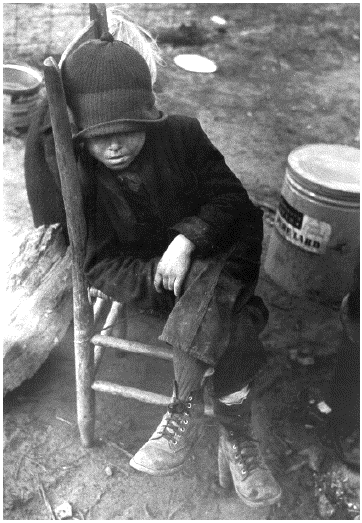 During the early years of the Depression in the United States, over 250,000 children were homeless, and, in some areas, 90% were malnourished.
During the early years of the Depression in the United States, over 250,000 children were homeless, and, in some areas, 90% were malnourished.In 1932, Clarence E. Pickett reported to Congress that --- depending on the school --- 20 - 90 percent of the children that the American Friends Service Committee had surveyed were underweight, suffering from rickets, pellagra, malnutrition, lethargy and sleeplessness.
In Chicago, 11,000 children in the public schools were being assisted by their teachers who paid for their food out of their own pockets. 3,000,000 children had to leave the educational system to take jobs, but there was no protection from exploitation because there were no child-labor laws.Over 15,000 young people were working in saw-mills, another 15,000 mining coal, and 5,000 more in steel mills. Younger children were paid less than the older ones --- in some cases they received not much more than 50 cents a week. Wages were as low as two cents an hour.
Beginning in 1935, the New Deal wanted to record its works to alleviate poverty, malnutrition, unemployment, low wages, and the general misery that was part of the Depression. It also saw the project as a chance to give employment to starving photographers. Roy Stryker was hired by the Resettlement Administration and the Farm Security Administration to find and give work to likes of Walker Evans, Arthur Rothstein, Dorothea Lange, Ben Shahn.Between 1935 and 1943, the RA and the FSA made more than 200,000 photographs of American life --- an astonishing record of the good and the bad of the U. S. The photographs were generally superb and the photographers given immense latitude in what they were to record.
Go to
the complete
reviewSepharad
Antonio Muñoz Molina
Margaret S. Peden, Translator
(Harcourt)Exiles and prisoners and those on the run and those who can never go home again. Some, like Neumann or Trotsky or Klemperer, were well-known; many of the others described here are anonymous --- now only known because Muñoz has retold their stories here. Such as Señor Isaac Salama whose father brought him to Tangier just before WWII. He grew weary of the stories of his mother and two sisters who had perished at an unnamed, tiny, little-known camp in Poland. When he is fourteen, he finally escapes by boat from Tangier to Spain:You can't imagine the weight that was lifted from my shoulders --- free of father and his shop and his mourning and all the Jews killed by Hitler, all the lists of names in the synagogue...
And then, at the age of twenty-two, Isaac Salama is paralyzed in an automobile accident in Spain. He compares his disability to being a Jew,
At that time in my life [during his childhood], being a Jew gave me the same sense of shame and the same rage I felt after I was paralyzed, crippled --- none of this 'impaired' or 'disabled' drivel, which is what those imbeciles say now, as if changing the world could erase the stigma and give me back the use of my legs. When I was nine or ten, in Budapest, what I wanted was not for us Jews to be saved from the Nazis, I say it now, to my shame: what I wanted was not to be a Jew.
Amidst all these stories of pain and isolation and loss of home, there is one which is not only the most gripping, but like a jewel buried in the coal mine, is the most merry. It is the one that put us most in mind of Boccaccio. It's Mateo the shoemaker's memory of his seduction.
It was no simple seduction: he was given a whispered invitation to go to the nunnery not far from his shoe shop, the Convent of Santa Clara. The invitation came from Sister María del Gólgota.
She told him that at midnight, he would see the lights flash in the tower, and he would go to a small door in the base, and push on it, and when he entered, and climbed the steps, he would find her.
He did so, and there in the dark, he found himself "licked, bitten, instructed, crushed by a naked body that became so entangled with his that he couldn't tell, in the daze of his excitement and the darkness, what he was touching or what was touching him."
He was shaken like a rag doll, shoved against a wall that chilled and scraped his shoulder, muzzled by a sweaty hand when his breathing became too loud, tossed as if by a powerful wave, then held as he fell to the floor.
This story, "America," shows Muñoz' excellent, driving narrative power. As they say in the Michelin guides, it is "vaut le voyage."
Go to the complete
reviewHaiku
Translated and Edited
By R. H. Blyth
(Heian International)How does one teach haiku? Could one have students visualize what is, after all, a very hum-drum scene: and then try to capture it in a few words? We don't envy the task of such teachers. It might be impossible to instruct students who have shut themselves off from the rich interrelationship of time and objects and the poignant (perhaps as yet unexperienced) sense of aging, growing, dying --- all necessary to feel the tide of emotion that can flow from twelve words.But Blythe is quick to point out that Haiku is not all fruit-blossom and frog-croak ponds. As contrast, he gives us the words of St. Paul The whole creation groaneth and travaileth together until now, waiting for the manifestation of the sons of God, and immediately contrasts this to:
For you fleas too,
The night must be long,
It must be lonely.--- IssaAnd in the reading (and rereading) of such words, we are captured by the humanity of the poet --- one who must be troubled enough (and humble enough) to speak to the very insects who perhaps too are experiencing a long sleepless night, far from home, far from loves and from friends. It is the wit and joy and acceptance that come together in divine understatement:The autumn storm;
A prostitute shack,
At 24 cents a time.--- Issa
in which the loneliness of paid-for sex is joined and shaped by a chance October storm; all presented to us together as a bouquet --- lovingly given in so few syllables.Once when I was watching Japanese television, I saw a Haiku competition. There were various contestants, and among them was the Emperor of Japan. Such a frail and studious and serious man he was. At the time, I remembered thinking how nice it would be if the leaders of the United States joined together with some kids, some common home folk, a few truck-drivers, all of us, to read (and write) some haiku. Clinton writing about frogs jumping into ponds, Alan Greenspan with three lines on the sparrows in the streets of New York, touched by the wind. The governor of California, of Florida, of New York God knows, with a few vignettes on the ocean's evening's wave, or taking a moment, as Taigi did, to reflect on going home late at night:
Not a single stone
To throw at the dog,
The wintry moon.
How human they would become! How they would join the common resonance of the world about us. How fine for them, for a moment, to stop the giant wars called the Affairs of State --- stop to reflect lovingly, for a moment, on the loving details that are all about us; viewing --- for instance --- a tiny mote in the eye of an insect, as Issa did.Go to the complete
review
Art
Over 2,500 Works from
Cave to Contemporary
Foreword by Ross King
(DK)The prejudice in Art is shown by the artists who get more than an eighth or a quarter or a half-a-page. Seurat gets five which is OK by me: anyone who would drive themselves nuts by dividing their paintings into seven-million colored dots deserves some space. My beloved Matisse only merits three pages, with the atypically sad Sadness of the King getting top billing. Picasso rakes in the sweepstakes with eight full pages, four dedicated to Guernica alone. Stupendous Modigliani gets only one, Soutine --- no dead dogs allowed --- a half-a-page.My other hero, Henri Rousseau --- they call him a primitive --- gets but a page, while that overblown Salvador Dali is awarded three-and-a-half ... including a lobster atop a telephone. The editors assure us that "both hard-shelled objects, lobsters and telephones held powerful sexual associations for Dali." Waiter, hold the Lobster Newberg.
The big bore Robert Rauschenberg gets three pages, Jasper Johns two, and that dunce Andy Warhol two too many, along with his cynical quote "Making money is art, and working is art, and good business is the best art."
One of the editors, don't ask me who, in the chapter entitled "Post-war Europe" --- which war, there've been so many? --- tries to define Existentialism in sixty-five words. War also gets full billing on pages 510 - 511, fifteen paintings and a bas-relief squashed into two pages, in one of those all-encumbering theme pages ("Myth and Legend," "Animals," "Nudes," "Portraits.")
The eccentric but wonderful Thomas Hart Benton is mashed into but 1/6th of a page, just below Grant Wood and across from Edward Hopper. Semi-realist Georgia O'Keeffe merits a little over a half-a-page, and, she tells us, "Nothing is less real than realism." Diego Rivera is shrunk down to 2-1/2 paintings whereas wife Frida gets a full page. A box on page 499 tries to cram the whole of the "Mexican Revolution 1910 - 1920" into twenty words.
Jackson Pollock's inchoate drip-ery gets five pages, although he has to share a part of page 503 with Peggy Guggenheim who is quoted as saying that he was "the strongest painter of his generation." Stronger than what?
As far as we are concerned, you can quit this volume when you get to page 500 ... Abstract Expressionism, Pop Art, Kinetic Art, Minimal Art, Conceptual Art ... each one sillier and sillier. And by the time you arrive at Superrealism, Neorealism, Sacrorealism, Synchrorealism, Pantheocreaticrealism ... why, you might just as well hang it up. The lobster, that is.
Go to the complete
review
